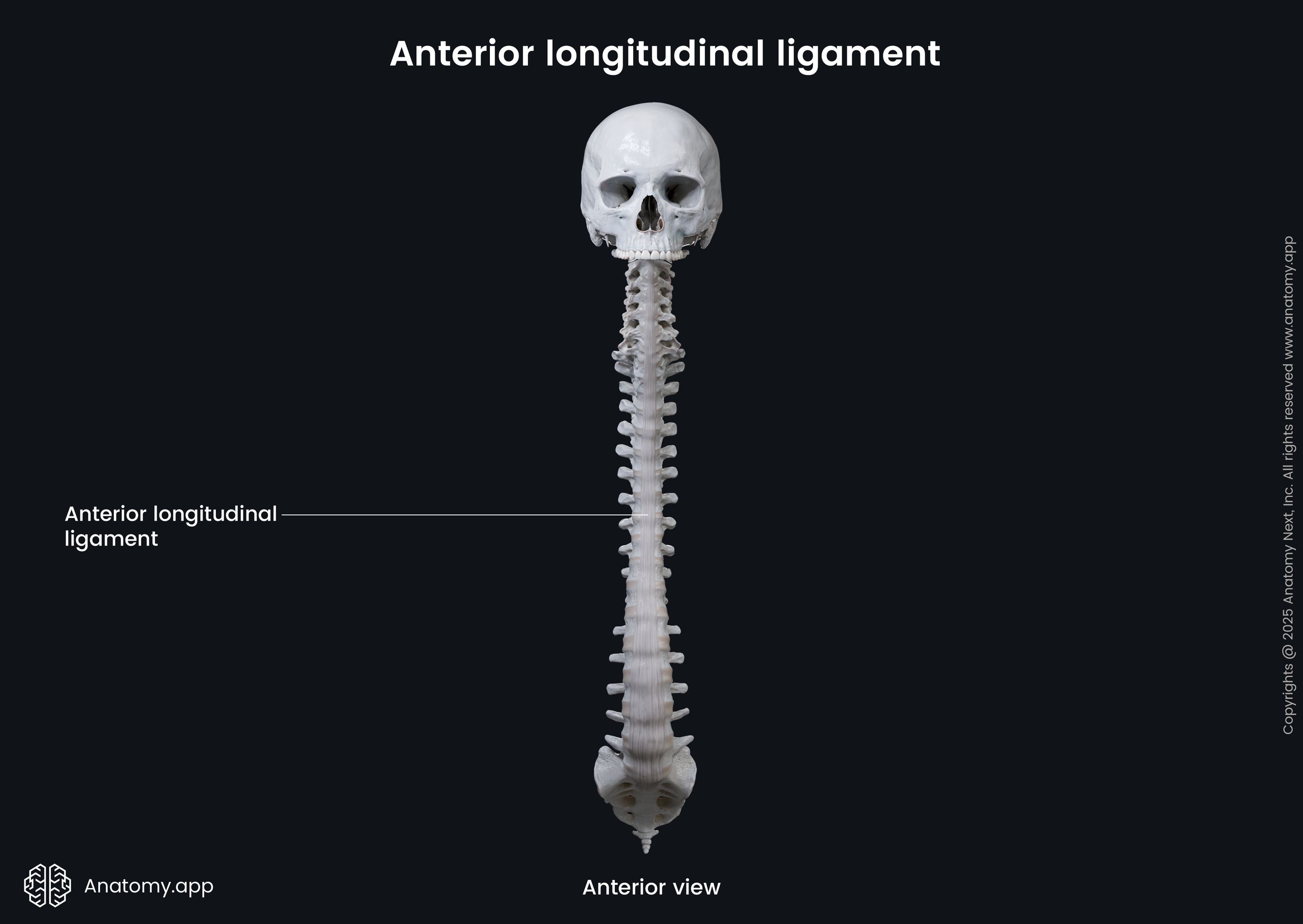- Anatomical terminology
- Skeletal system
- Joints
- Classification of joints
- Joints of skull
- Joints of spine
- Joints of lower limb
- Muscles
- Heart
- Blood vessels
- Lymphatic system
- Nervous system
- Respiratory system
- Digestive system
- Urinary system
- Female reproductive system
- Male reproductive system
- Endocrine glands
- Eye
- Ear
Anterior longitudinal ligament
The anterior longitudinal ligament (Latin: ligamentum longitudinale anterius) is a strong band that extends anteriorly along the entire length of the vertebral column. It is one of the primary ligaments that are crucial for the stability of the spinal structures.

Anterior longitudinal ligament anatomy
The anterior longitudinal ligament attaches to the anterior surfaces of the vertebral bodies and their respective intervertebral discs. It extends from the basilar part of the occipital bone, crosses over the anterior tubercle of the atlas (first cervical vertebra - C1), covers the anterior part of the axis (second cervical vertebra - C2) and then continues further down the vertebral column. The anterior longitudinal ligament terminates in the pelvic surface of the upper sacral vertebrae (sacrum).

Typically, the anterior longitudinal ligament is narrower and thicker in the thoracic part of the spine. It becomes broader towards the sacrum. In the lumbar spine, the anterior longitudinal ligament takes up almost half of the total circumference of the vertebral bodies. Also, this ligament is thicker and narrower where it covers the vertebral bodies compared to where it covers intervertebral discs.

Anterior longitudinal ligament composition
The anterior longitudinal ligament is composed of multiple layers - deep, intermediate and superficial. The deep layer of fibers covers only two adjacent vertebrae. The intermediate layer of the ligament spans across two or three vertebral bodies. In contrast, the superficial (outer) layer simultaneously connects up to five vertebral bodies.
The fibers of the ligament firmly adhere to the intervertebral discs. They bond to the annulus fibrosus, hyaline cartilages of the end-plates and margins of the adjacent vertebral bodies. While covering the vertebral bodies, the fibers of the anterior longitudinal ligament also blend with the periosteum and perichondrium.
Anterior longitudinal ligament function
The anterior longitudinal ligament contributes to the stability of the entire spine, and it is one of its primary stabilizers. Because of its strength, this ligament is essential in the lumbar region. The lumbar spine bears the weight of the entire body. The anterior longitudinal ligament is the only ligament of the spine that limits extension, stabilizing all components of the vertebral column and preventing posterior and anterior movements of the adjacent vertebral bodies.
References:
- Gray, H., & Carter, H. (2021). Gray’s Anatomy (Leatherbound Classics) (Leatherbound Classic Collection) by F.R.S. Henry Gray (2011) Leather Bound (2010th Edition). Barnes & Noble.
- Paulsen, F., Waschke, J., Hombach-Klonisch, S., Klonisch, T., & Peeler, J. (2019). Sobotta Clinical Atlas of Human Anatomy, one volume, English (1st ed.). Urban & Fischer.
- Steinmetz, M., & Benzel, E. (2016). Benzel’s Spine Surgery, 2-Volume Set: Techniques, Complication Avoidance and Management (4th ed.). Elsevier.
- Watson, C., Paxinos, G., & Kayalioglu, G. (2008). The Spinal Cord: A Christopher and Dana Reeve Foundation Text and Atlas (1st ed.). Academic Press.